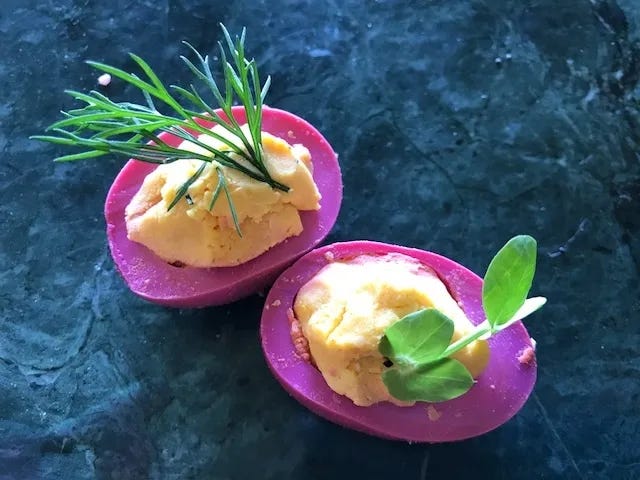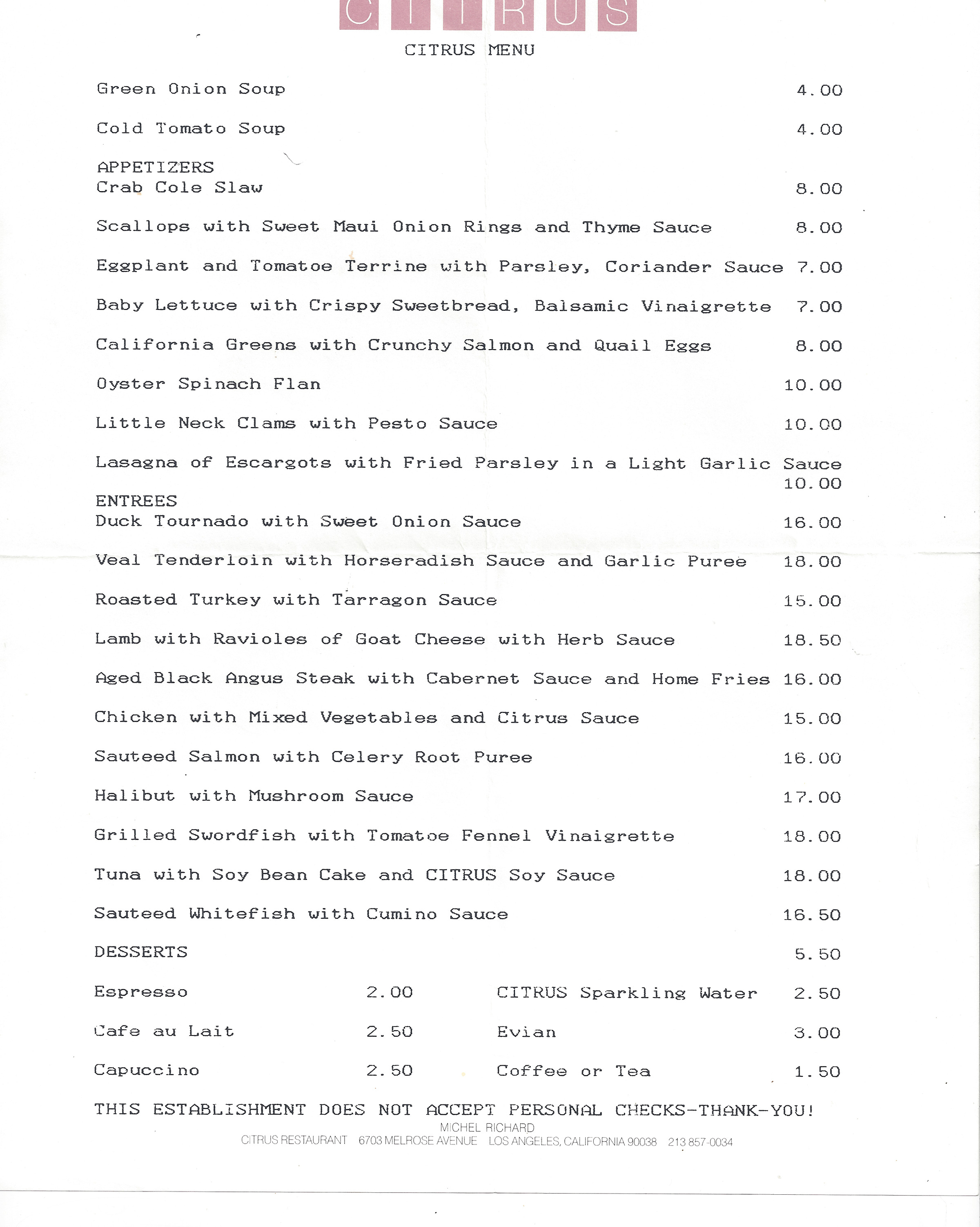This week I was invited to “live my most tasteful life” by joining something called Taste Club.
I’ve heard about these restaurant concierge services, of course, but I’ve never given them much thought. But as I began reading my blood began to boil.
This “service” takes everything I love about restaurants and turns it on is head.
Restaurants as we know them were created during the French revolution when the chefs of former aristocrats made their services available to all comers. They created democratic institutions - places where anyone with a few sous could eat like a prince.
Over the years restaurants evolved in various ways. In France they were places where ordinary people could indulge in the fantasy, for at least a little while, that they were born to the purple. But when restaurants crossed the Atlantic they morphed into something else - melting pots where people who had never traveled more than a few miles could experience how people in the far corners of the world were eating. And for many immigrants they became the entryway into this new land.
Until recently most of us thought of of restaurants as places to eat. But that perception changed during the pandemic. When restaurants shut their doors we realized it wasn’t the food we missed most- it was everything else. We longed for the opportunity to step out of our daily routines, lose ourselves among strangers and be seduced by endless possibilities. In an increasingly virtual world, restaurants are grounded in real time and real sensations.
I love restaurants. I always have. And I hate that “services” like Taste Club are introducing “exclusivity” “access” and “privacy” to places that once belonged to us all. I know it’s just another sign of the one percent world we now live in, but I find it appalling that what were public institutions are turning into private clubs. It makes me incredibly sad that so many of my favorite restaurants are signing on, setting up barriers, telling us that we might not be the right people to walk through their doors.
Wonder what it costs? So did I. The website is remarkably coy. It tells you that membership is a “transferable asset,” but the price of that asset is never mentioned. Trolling around I discovered that the price might be $5,000 for the first year and $3,600 a year thereafter. But elsewhere I found other, even higher prices.
No matter what it costs, I’m not buying.
Michael’s birthday was last week, and a lot of people came over to celebrate the occasion. Deviled eggs are among Michael’s favorite foods, so I decided to make these pink ones. They’re so beautiful you get a lot of bang for very few bucks.
(Incidentally, I usually use Sriracha in the recipe, but like many people I am suffering from Sriracha deprivation due to the shortage of Huy Tung Sriracha, which is currently selling for a staggery $75 at Amazon. According to the Los Angeles Times the company goes through 50,000 tons of Mexican chiles a year and the draught south of the border has created a chile shortage. I haven’t found another brand I like, so I used Tabasco in its place.
Pink Deviled Eggs
1 dozen hard boiled eggs
1 jar pickled beets
Tabasco
mustard
mayonnaise,
salt pepper
Once your eggs are cooked and peeled, put the whole eggs into a bowl with the juice from a can of pickled beets; add a bit of water if the eggs aren’t completely covered.
Before long the eggs will begin to turn a vibrant shade of pink. Leave them in the refrigerator overnight, and the whites will be the most beautiful color, a dazzling contrast to the marigold color of the yolks. (Leave them in the beet juice for more than 18 hours, however, and the yolks will turn pink as well.)
Cut the eggs in half lengthwise, then slice a bit off the bottom of the white of each half so they won’t wobble on the plate. It make them considerably easier to fill. Remove the yolks and mash with mayonnaise, a bit of mustard, and salt and pepper. Add a splash of Tabasco for heat.
If you want truly etherial tenderness, whip the filling in a food processor; it will make it smoother. Then pile the deviled yolks back into the pink shells. (A pastry tube makes this easier.)
At the end, just for color, top each one with a little leaf of herb.
A small digression on the science of hardboiled eggs….
When eggs are new, the membrane beneath the shell sticks tightly to its shell, making peeling them a serious challenge. As eggs age, the protective coating on the shell becomes porous and begins to absorb air making the whites less acetic. (This is why the whites of freshly laid eggs are cloudy; as they absorb air they lose some of the carbon dioxide in the albumen, the ph rises, and the whites become clearer.)
But while the egg whites are losing their acidity, they are also getting thinner, meaning that the yolk is moving farther from the center. So if you’re intent on perfect deviled eggs, begin with organic, new-laid eggs but put them in the refrigerator for a week and store them on their sides.
When you’re ready to hard-boil them, bring the eggs to room temperature (which will keep them from cracking). Put your eggs in a pot that will hold them in a single layer, so that they cook evenly. Cover them with cold water and raise it quickly just to a boil. Cover the pot, turn off the heat and let the eggs sit for 12 minutes.
Chill the eggs, immediately, in a bowl of ice water. This will prevent the dread green circle around the outside of the yolk. (That occurs because the iron in the yolk reacts with the sulfur in the white when the temperature of the egg reaches 158° F. Although perfectly harmless, it lends your deviled eggs a slightly ghoulish air. )
If you don't want to wait a week, steam your eggs. It's easy. Put them in a steamer (or a colander over a big pot), cover them and steam for twenty minutes. Plunk them into an ice water bath until they’re cool enough to handle. Roll on the counter. The shells of even new-laid eggs will peel right off.
Another lost recipe from Save Me the Plums. This is from the chapter called Attire Allowance.
“She must have liked you better than you think.” Kathy’s voice was brisk. “Because Condé Nast just called to make an offer. Do you want to hear the terms?”
Two minutes later I hung up in a daze. All around me the newsroom buzzed, familiar, cheerfully distracting. My fingers shook as I dialed to cancel the reservation at Les Celebrites, the fancy new restaurant I was supposed to be reviewing; Michael and I could not possibly discuss this in the middle of a packed room, where we could be overheard. Then, still dizzy, I turned off my computer and picked up my purse.
I considered dinner as I rode the subway. I’d stop at Citarella to buy some shrimp, make that Marcella Hazan pasta Nick and Michael liked so much. I’d get a bottle of wine. A bunch of flowers. Bake brownies.
At home I stood in the kitchen, mind spinning as I stripped shells from the shrimp. In the living room Nick and his friend Zack were doing math homework. The murmur of their voices made this seem like any other day.
“You boys hungry?”
After years of insisting on five white foods, my son’s appetites had abruptly changed; he was now on the constant prowl for interesting snacks. “Any more of those deviled eggs?” he shouted back.
I put the eggs on a plate and carried them into the living room; they were slightly smashed, which gave them a rakish air, but the boys didn’t seem to mind. I’d finished cleaning the shrimp by the time Michael walked in, but I was still at the sink, my hands beneath the running water.
Celebration Shrimp Pasta (adapted from Marcella Hazan)
1 pound medium-size wild shrimp, in the shell
1/4 cup olive oil
3 garlic cloves, smashed
2 tablespoons tomato paste
1/2 cup white wine
3/4 cups cream
salt and pepper
Shell the shrimp, rinse them well and dry them completely with paper towels.
Put the olive oil in a large saucepan over medium heat. Add the garlic and cook for a minute or so, until it sends its fragrance into the air. Stir the tomato paste into the wine and add it, very carefully to the pan. Cook for about ten minutes, stirring from time to time.
Add the shrimp, salt and pepper and cook for a couple of minutes, stirring, just until the shrimp turn pink and lose their translucence. Take the pan off the stove.
Remove all the shrimp from the pan. Put half of them into a food processor, puree them and add them back to the pan. Cut the remaining shrimp into bite-sized pieces and set aside.
Add the cream to the pureed shrimp and cook, stirring for a minute or so, until the cream warms and the sauce thickens. Taste for seasoning. Add the remaining shrimp, quickly toss with a pound of cooked spaghetti and serve to 4 people.
When I think about the great meals of my life, Michel Richard always comes to mind. He was a man who was always happy in the kitchen, a chef whose favorite occupation was throwing away the menu so he could create something special just for you.
Michel started life as a pastry chef - and was of the generation that learned to pull sugar. He made the most beautiful deserts, but his imagination was too large to stick to sweets. He hungered to do more. In 1987 he opened Citrus in Los Angeles and it quickly became one of the most exciting places to eat in the city. He went on to open restaurants in DC, Las Vegas and New York - but Citrus was always my favorite. You can read my review here.
Michel was incredibly imaginative and technically skilled. (I once timed him carving a turkey; it took him 15 seconds.) The combination gave him the ability to think out of the box. For a look into his mind you can’t do better than his book I Am Always Happy in the Kitchen, which is filled with original ideas (see faux gras and lo-carb carbonara).
This was, I believe, the restaurant’s opening menu. Looking at it now I realize there’s not a single dish I wouldn’t happily eat today.










I totally agree with you about these access and exclusivity services. It’s so crass and caters to a ridiculous kind of financial excess and elitism.
And on another more upbeat note, I just wanted to say how much I enjoy reading your newsletter! Thank you!!
Thanks for your thoughts on “clubs” like Taste Club. I agree completely.